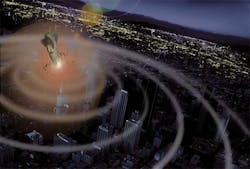Raytheon to integrate high-power electromagnetics (HPEM) into cyber and electronic warfare (EW)
Officials of the Air Force Research Laboratory (AFRL) Directed Energy Directorate's High-Powered Electromagnetics Division (RDH) at Kirtland Air Force Base, N.M., announced a $10 million contract Wednesday to the Raytheon Missile Systems segment in Tucson, Ariz., for the High Power Electromagnetics Cyber Electronic Warfare Applications (HPEM CEWA) program.
The HPEM Cyber and EW project seeks to find ways to apply HPEM technologies to military cyber and EW applications by conducting experiments, demonstrating concepts, and documenting results.
Raytheon experts will identify and develop HPEM technologies with the potential to complement and enhance mission effectiveness of the cyber and EW communities. This includes the study, analysis, and information scenarios in which HPEM can be used for cyber or EW applications, conduct, experiments, and demonstrative concepts.
The HPEM Cyber and EW program will use existing and emerging HPEM RF source and software technologies suitable for existing and future military systems by developing and refining a library of potential mission scenarios that contrast how business is conducted today, and how HPEM technologies could improve cyber and EW development in the future.
Related: Air Force looking for power sources and antennas for future high-power microwave weapons
Raytheon experts will conduct experiments to identify RF parameters such as carrier frequency, pulse repetition frequency, and incident power density as design guidelines for new HPEM sources.
Electromagnetic and cyber realms overlap, Air Force researchers point out, because cyber technologies operate in the electromagnetic spectrum more than ever before. The HPEM Cyber and EW program seeks to investigate concepts beyond the obvious front door coupling paths into routers and other wireless devices.
Air Force officials say they expect to award as many as three separate $10 million contracts for the program. Raytheon is the third contract in this round of the HPEM CEWA program. Booz Allen Hamilton in McLean, Va., was selected on 7 March, and CSRA LLC in Chantilly, Va., was selected on 30 March.
Raytheon won a similar contract earlier this month from the Air Force Research Laboratory Directed Energy Directorate to investigate ways to integrate future HPEM technologies into aircraft, potentially to create electronics-killing electromagnetic pulse (EMP) weapons.
Air Force researchers began the HPEM CEWA program 2013 to find new ways of using HPEM technologies to improve cyber warfare and electronic warfare capabilities. Previous efforts have centered on HPEM technologies for directed-energy weapons. The program thus far has produced creative ideas for using single-shot HPEM technology, multi-shot HPEM technology, and specialized waveform technologies.
The newest objectives for the program involve effects caused by backdoor coupling phenomenology and concepts unique to exposing test assets to high-power densities.
Researchers want to identify the radio frequency power density, pulse width, pulse repetition rate, and other parameters based on cyber and EW experiments. Experts want to understand how robust HPEM effects can be in cyber and EW applications based on experiments.
To prove new concepts, Air Force researchers want Raytheon, Booz Allen and CSRA to demonstrate technical HPEM concepts at field experiments such as Black Dart or Vigilant Hammer.
On this contract Raytheon will do the work at Kirtland Air Force Base in Albuquerque, N.M., and should be finished by August 2020. For more information contact Raytheon Missile Systems www.raytheon.com, or the Air Force Research Laboratory's High-Powered Electromagnetics Division at www.kirtland.af.mil/Units/AFRL-Directed-Energy-Directorate.
Also contact Booz-Allen Hamilton online at www.boozallen.com, or CSRA LLC at www.csra.com.
Learn more: search the Aerospace & Defense Buyer's Guide for companies, new products, press releases, and videos
